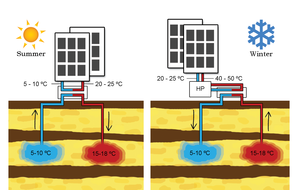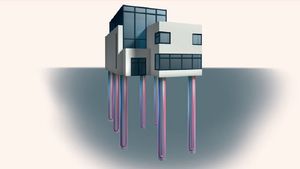Theme 3: Thermal energy
Deliver heat, in the right place, at the right time and at the right temperature
We need:
• Technology in place to deliver heat efficiently to all parties in the urban environment.
• Reliable and predictable thermal heating systems, enabled by robust business models.
• Integrated solutions connecting distributed and centralised sources, and on-demand storage facilities.
Research challenges
• Better predictions of geothermal source and storage performance.
• Development of high-efficiency, low-noise and low-cost heat pumps.
• Governance of heat and electricity infrastructure, such as underground management and optimisation.
• Balancing heat demand and supply over the year
• Integration of renewable sources of different scales into district heating networks.
Examples of TU Delft projects
Aquifer Thermal Energy Storage (ATES) Heat is a major part of the worldwide energy requirement (space heating/cooling, industry, etc.). Like with many other renewable or sustainable energy sources, with sustainable heat the biggest challenge is dealing with the variability in the availability and demand. Heat storage is an important solutions to match heat availability to demand. Aquifer Thermal Energy Storage (ATES) is one of the important geothermal energy technologies needed to utilize sustainable heating and cooling systems of buildings – and in particular, provides cheap and large scale storage. Both, high quality research and education as well as large scale adoption of ATES technology are needed during the coming decades at national and international level. Read more.
Heat is a major part of the worldwide energy requirement (space heating/cooling, industry, etc.). Like with many other renewable or sustainable energy sources, with sustainable heat the biggest challenge is dealing with the variability in the availability and demand. Heat storage is an important solutions to match heat availability to demand. Aquifer Thermal Energy Storage (ATES) is one of the important geothermal energy technologies needed to utilize sustainable heating and cooling systems of buildings – and in particular, provides cheap and large scale storage. Both, high quality research and education as well as large scale adoption of ATES technology are needed during the coming decades at national and international level. Read more.
Energy piles
Energy piles are building foundations that also provide heating and cooling. The use of geothermal heat can reduce fossil energy consumption considerably. A full-scale energy pile demonstrator will be complemented with lab-scale experiments at The Green Village on the TU Delft campus. Parameters such as efficiency, design methods and energy saving potential are investigated for short-term (seasonal) and long-term (years) periods.
Smart thermal grid at TU Delft
TU Delft’s campus heating network is connected to 23 buildings and used as a ‘living lab’ to demonstrate the transition of a conventional district heating grid towards a renewables-driven fourth-generation district-heating network. The first step involves an anticipative and peak-shaving control strategy to minimise the supply temperature, which is necessary to integrate a future geothermal source into the network. This first step already showed a 20% reduction of natural gas consumption without having to make any large-scale modifications to buildings or heat sources.
Contact for this theme is Phil Vardon
Website: this theme has its own website: Thermal-X